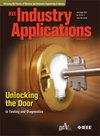全电船舶动力系统中电力电子构件的实时改进最近液位控制
IF 4.5
2区 工程技术
Q2 ENGINEERING, ELECTRICAL & ELECTRONIC
引用次数: 0
摘要
电力电子构建模块(PEBB)概念涉及将基本组件集成到可堆叠的功能模块中,从而扩展全电动船舶(AESs)的转换器额定功率。这种模块化方法降低了成本、尺寸、重量、设计复杂性和维护。pebb可以作为模块化多电平转换器(mmc)实现,具有模块化、低开关损耗、最小电压/电流量化、高可靠性和高效率等优点。然而,有效的开关控制方法对于平衡电容器电压和抑制循环电流至关重要。本文提出了一种改进的最近电平控制(NLC)方法,该方法采用平滑的梯形参考信号代替正弦参考信号,以增强电容器电压平衡,抑制循环电流,提高AESs中pebb的输出电能质量。针对n级PEBB在变速转矩负载下与感应电机连接的情况,对NLC方法进行了实时分析。在台风HIL606数字实时模拟器(DRTS)上进行了实时验证。结果验证了NLC方法用于AESs三相n级PEBB概念的可行性和有效性。本文章由计算机程序翻译,如有差异,请以英文原文为准。
Real-time Improved Nearest Level Control for Power Electronics Building Blocks in All-Electric Ship Power Systems
Power electronics building block (PEBB) concept involves integrating fundamental components into functional blocks that can be stacked, extending converter power ratings for all-electric ships (AESs). This modular approach reduces costs, size, weight, design complexity, and maintenance. PEBBs can be realized as modular multi-level converters (MMCs), which offer advantages like modularity, low switching losses, minimal voltage/current quantization, high reliability, and efficiency. However, effective switching control methods are crucial to balance capacitor voltages and suppress circulating currents. This paper proposes an improved nearest level control (NLC) method that employs smoothed trapezoidal reference signals instead of sinusoidal references, aiming to enhance capacitor voltage balancing, suppress circulating currents, and improve the output power quality of PEBBs in AESs. The proposed NLC method is analyzed in real-time for an N-level PEBB connected to an induction machine (IM) with variable speed and torque load. The real-time verification is conducted in the Typhoon HIL606 digital real-time simulator (DRTS). The results validate the feasibility and effectiveness of the proposed NLC method for a three-phase N-level PEBB concept for AESs.
求助全文
通过发布文献求助,成功后即可免费获取论文全文。
去求助
来源期刊

IEEE Transactions on Industry Applications
工程技术-工程:电子与电气
CiteScore
9.90
自引率
9.10%
发文量
747
审稿时长
3.3 months
期刊介绍:
The scope of the IEEE Transactions on Industry Applications includes all scope items of the IEEE Industry Applications Society, that is, the advancement of the theory and practice of electrical and electronic engineering in the development, design, manufacture, and application of electrical systems, apparatus, devices, and controls to the processes and equipment of industry and commerce; the promotion of safe, reliable, and economic installations; industry leadership in energy conservation and environmental, health, and safety issues; the creation of voluntary engineering standards and recommended practices; and the professional development of its membership.
 求助内容:
求助内容: 应助结果提醒方式:
应助结果提醒方式:


